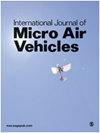基于SAMURAI的前掠翼无人机不确定设计优化
IF 1.5
4区 工程技术
Q2 ENGINEERING, AEROSPACE
引用次数: 0
摘要
本文研究了前掠翼(FSW)混合翼身(BWB)无人机的不确定设计优化问题。传统的bwb通常是无尾的,这导致后掠翼,以确保纵向静稳定性。这反过来又会引起尖端的流动分离,导致升力、可控性的损失和俯仰力矩的出现。这个问题的一个可能解决方案是通过引入前掠翼来进行概念性的重新设计,这种设计本质上是没有倾斜失速的,但需要仔细设计才能控制。然而,固定翼无人机通常采用直接注射膨胀泡沫成型的方式生产,其特点是生产公差不可忽略。这导致了一个基于可靠性的稳健设计优化问题,为此采用了一个新的框架:SAMURAI。首先,该方法通过代理建模、问题的解析处理和平衡设计空间探索和目标开发的异步更新方案来计算计算成本。其次,该方法将该问题视为一个多目标问题,使设计具有鲁棒性和可靠性。结果得到了一系列具有固有无尖失速、鲁棒性和满足稳定性要求的新型无人机设计,并在计算可行的预算范围内获得了目标可靠性。本文章由计算机程序翻译,如有差异,请以英文原文为准。
Design optimization-under-uncertainty of a forward swept wing unmanned aerial vehicle using SAMURAI
In this paper the design optimization-under-uncertainty of a forward swept wing (FSW) blended wing body (BWB) unmanned aerial vehicle (UAV) is examined. Conventional BWBs are often tailless, which leads to a backward swept wing to ensure longitudinal static stability. This in turn can induce flow separation at the tip, leading to a loss of lift, controllability and the appearance of a nose-up pitching moment. A possible solution to this problem is a conceptual redesign by introducing a forward swept wing, which is inherently free of tip-stall, but needs a careful design in order to be controllable. However, fixed wing UAVs are often produced by means of direct injection expanded foam moulding, which is characterized by not negligible production tolerances. This lead to a reliability-based robust design optimization problem, for which a novel framework is employed: SAMURAI. Firstly, the method accounts for computational cost by means of surrogate modelling, an analytical treatment of the problem and an asynchronous updating scheme that balances design space exploration and objective exploitation. Secondly, the method treats the problem as a multi-objective problem, which leads to a Pareto front of robust and reliable designs. The result is a novel series of UAV designs that are inherently free of tip stall, perform robustly and meet the stability requirements with the target reliability obtained with a computationally feasible budget.
求助全文
通过发布文献求助,成功后即可免费获取论文全文。
去求助
来源期刊

International Journal of Micro Air Vehicles
ENGINEERING, AEROSPACE-
CiteScore
3.00
自引率
7.10%
发文量
13
审稿时长
>12 weeks
期刊介绍:
The role of the International Journal of Micro Air Vehicles is to provide the scientific and engineering community with a peer-reviewed open access journal dedicated to publishing high-quality technical articles summarizing both fundamental and applied research in the area of micro air vehicles.
 求助内容:
求助内容: 应助结果提醒方式:
应助结果提醒方式:


